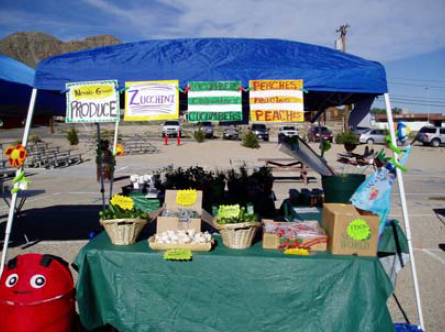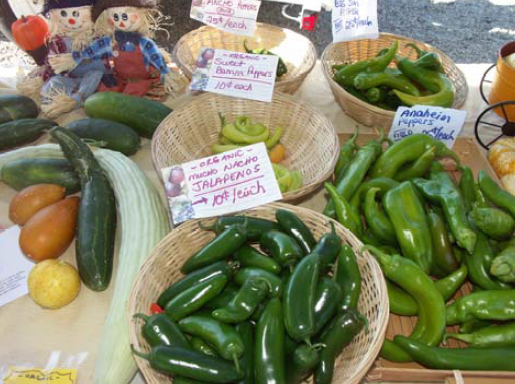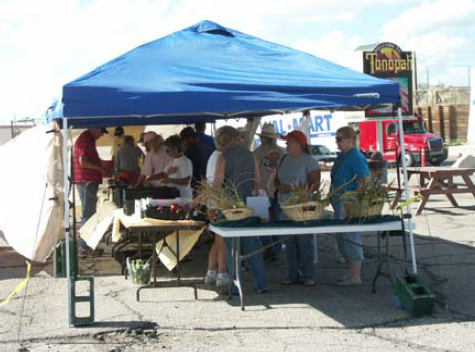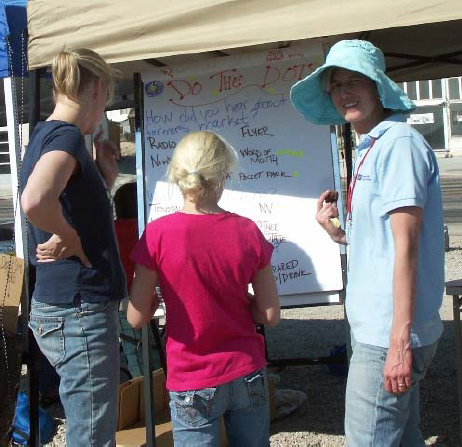Introduction
This fact sheet offers strategies to attract and keep vendors and customers at rural farmers markets. Some of these strategies were effectively practiced with a farmers market in Tonopah, Nevada - a remote and rural town where the farmers market grew to 15 vendors and 250 customers each week within four years.
Placing emphasis on attracting vendors and customers can result in successful farmers markets in rural communities. Maintaining a careful balance between the number of vendors and number of customers is important to ensure that supply and demand are such that everyone feels like the market is worth the effort of participating.
Focus on vendors
Some rural farmers markets have difficulty drawing in vendors, particularly when distances are far and the potential number of customers is small.
A study in Oregon by Lev, Brewer, and Stephenson (2008) suggested that low numbers of vendors contributed to the failure of farmers markets. However, market managers can use certain strategies that can help attract and retain vendors at their markets to avoid market failure.

Understand and Communicate the Benefits to Vendors
Prior to corresponding with potential vendors, it is important to be able to articulate the benefits of selling at a farmers market. According to Govindasamy, Italia and Adelaga (2002), “Farmers' markets are offering producers a unique opportunity to obtain better profit margins by selling agricultural produce directly to the consumer, despite increasing production costs.”
Indeed, the economic advantages are plentiful (Abel, Thomson, & Maretzki, 1999.), including:
- Supplemental income for farmers
- Part-time grower expansion
- Higher percentage of gross returns to producers selling at farmers markets compared to wholesalers/distributers
Additionally, many producers prefer farmers markets over other forms of direct marketing because it allows them to have a personal relationship with their customers.
Since there may be competition between farmers markets in recruiting vendors, remember to highlight the benefits specific to your farmers market. Volunteers recruiting vendors to the Tonopah Farmers Market highlight:
- the weekly average number of customers
- Reduced vendor fees for local “mom and pop” vendors
- Hotel discounts for out-of-town vendors

Strategies to Attract Vendors
Armed with knowledge of the benefits of your farmers market, there are strategies you can use to gain committed vendors. Extending personal invitations to potential vendors rather than using a form letter can be an effective way to show your involvement with the market. Explaining the benefits to both the grower and the community can help persuade a vendor to participate. Community benefits that might be good to mention to potential vendors include (Abel, Thomson, & Maretzki, 1999.
- Increased economic activity for downtown area or businesses in the vicinity of the farmers market
- Popular source of fresh produce
- Unique opportunity to get involved with and support local food system
If the farmers market is open to vendors selling products other than produce, consider inviting small business owners and suggest that they use the venue to promote their business. For example, at the Tonopah Farmers Market, a masseuse encouraged future customers by bringing her massage table, offering 10-minute massages and setting up appointments. This also offers customers an additional incentive for attending the market.
Getting the Right Mix of Buyers and Sellers
Rural farmers markets can struggle with obtaining enough vendors to make the farmers market lively and attractive to customers. However, in securing vendors, it is necessary to also consider what products they can offer and to make sure that the vendors reflect the mission and goals of the farmers market. According to Ostrom and Lyons (2007), “Being able to amass a sufficient quantity and mix of farm products is the basis of market viability.”
Having a couple of produce vendors, along with other diverse farm products such as nursery stock, eggs, herbs, baked goods and related crafts, can create a wellrounded market. An “anchor” vendor helps make a market successful because customers can rely on them to be there consistently throughout the season to provide a variety of produce.
Organic produce has become an attraction to some farmers market customers (Jarosz, Jussaume, & Ostrom, 2002). Therefore, vendors that sell organic produce may appeal to a different customer, thereby broadening the clientele for the market.
Results from a survey in New Jersey revealed that, in terms of customers, “The overwhelming majority (98.5 percent) expect higher quality produce from farmers markets compared to that at other retail facilities.” (Govindasamy, Italia, & Adelaja, 2002, Consumption Trends of Fresh Produce section, ¶ 5). So, in order to attract and retain customers, it is important that high quality produce is consistently available.
Increasing Customers
There are several ways to increase the number of customers at a farmers market. Basic logistical details, such as when and where to hold the market, have a big impact on how many customers show up.

When to Hold the Market
In order to determine the time and day that will work best for your vendors and draw in customers, do research on which days other farmers markets run in the area and choose a different day so that vendors can go on a circuit. Local community practices should also be considered. For example, if a majority of small local businesses are closed on a specific day of the week, holding the market on that day may encourage business owners to participate. Residents of Tonopah typically go out of town on the weekends, so in order to draw in local customers, the market was held on a week day.
Location is Key to Success
When determining the location of the farmers market, invite community agencies to offer input in order to gain cooperation and support. Many markets are held on land owned by the town, county or other nonprofit organization such as a church.
Locate the market on a main road, which is visible from afar, with easy access, parking, shade, and room to expand as needed. Consider how many vendors are expected and how much room each one will need to make sure the site is appropriate for the farmers market. A site that is too small can feel crowded and does not encourage growth, yet a site that is too big presents challenges in making the market feel personal. The Tonopah Farmers Market takes place on property owned by the town, which provides the liability insurance, and is located right on Main Street to conveniently capture locals and those travelling through town as tourists or on business. A large, permanent sign and visible activity at the market site attracts people.
The atmosphere of the farmers market will impact the type of customers that visit and make it a weekly tradition for local residents. Special events, such as Local Heroes Day, Fall Harvest or Senior Day, that promote community cohesion, intergenerational interaction and socialization, have proven to generate activity and attract customers. Picnic tables, shade, bathrooms and live music make coming to the farmers market a pleasant experience and encourage people to shop, relax and catch up with friends.
Marketing Also Important
A successful marketing campaign will bring both vendors and customers to the farmers market. Be creative. Use as many approaches as your time, resources and imagination can produce.
Word-of-mouth is invaluable in a small town setting, so find the local people who always seem to know what is happening in town and get their support for the market (Meier, 2009). Feature stories and newspaper editorials catch the attention of a different reader and increase the power of ads. The Tonopah Farmers Market sold ad space to businesses and placed them on a poster advertising the market. A local restaurant used farmers market placemats, promoting the market to both locals and tourists. A radio ad enticed a new organic vendor and reminded customers about the farmers market.
Plan Evaluation Ahead of Time
Assessment of the farmers market is done to improve the market and to help ensure that customers, vendors and volunteers have a positive experience (Meier, 2008). Planning an evaluation strategy in advance is key to gathering credible and useful information. While there are many formal methods and tools to evaluate a market, simply training market managers and volunteers to write down observations and conversations throughout the season is invaluable.
Rapid market evaluation methods, such as crowd counting, dots surveys or debriefings can provide immediate feedback about the market (Lev, Brewer, & Stephenson, 2004). Volunteers count people who enter the market during the first 10 minutes of every hour. This number is then multiplied out to estimate the number of customers at each market. Recording crowd numbers is useful to determine which hours to hold the market, inform potential vendors or demonstrate the importance of the farmers market to the community. Crowd counting at the Tonopah Farmers Market determined that the average number of adult customers per week was 250, with peak hours from 4- 5 p.m. This information was used in a successful grant application and led to organizers altering their hours of operation.
“Doing the Dots” is an interactive customer survey. Customers place sticky dots on their answers to questions written on flipchart paper displayed on an easel at the market. Although only a few questions are asked because customers are there to shop, the responses will offer interesting insights. Some questions could be as basic as asking where customers live, while others might be about how much money they spent at businesses in the vicinity of the farmers market.
Formal surveys may be more time intensive, but can be very useful. For example, a weekly or seasonal vendor survey can be used to gather profit and product information or feedback on how the market is run. Surveys directed toward customers or community members in general (Curtis, Cowee, & Gatzke, 2009) will provide information on product preferences, spending habits and motivations. Using the information collected from formal evaluations and ongoing assessments will help attract vendors and customers to a farmers market.

Conclusions
Securing vendors and attracting customers can be an overwhelmingly task. Vendors will only come if there is a solid and large enough customer base; and customers will only come if there are vendors selling what they want to buy. However, ensuring that a farmers market attracts customers and vendors, particularly in rural communities, is a challenge that can be overcome using the strategies suggested in this fact sheet.
References
Abel, J.,Thomson, J. & Maretzki, A. (1999). Extension's Role with Farmers Markets: Working with Farmers, Consumers, and Communities. Journal of Extension [Online], 37(5) Article 5FEA4. Available at: Tiger Prints Site.
Curtis, K., Cowee, M., & Gatzke, H. (2009). Who is Shopping at Nevada’s Farmers Markets and Why? University Center for Economic Development. University of Nevada, Reno. UCED 2008/09-24. Access online: UNCE Site.
Govindasamy, R., Italia, J., & Adelaja, A. (2002). Farmers Markets: Consumer Trends, Preferences, and Characteristics. Journal of Extension [On-line], 40(1) Article 1RIB6. Available at: Tiger Prints Site.
Jarosz, L., Jussaume, R., & Ostrom, M. (2002). Food Consumption Attitudes and Behaviors, Results of a 2002 Consumer Survey. Washington State University.
Lev, L., Brewer, L., & Stephenson, G. (2004). Tools for Rapid Market Assessments. Oregon State University Extension Service. Access online: NOFA Site.
Meier, A. (2008). Developing Farmers Market Volunteers. University of Nevada Cooperative Extension. FS-08-48. Access online: UNCE Site.
Meier, A. (2009). Rural Farmers Markets: Challenges and Opportunities. Rural Connections. Western Rural Development Center. April 2009. Volume 3, Issue 2. Pp: 33-34. Logan, UT. Access online: USU Site.
Ostrom, M. & Lyons, Z. (2007). Washington State Farmers Market Manual. Washington State Department of Agriculture. AGR PUB 200-189. Access online: Food Systems Site.
Stephenson, G., Lev, L., & Brewer, L. (2008). When Things Don’t Work: Some insights into why farmers markets close. Oregon State University Extension Service. Special Report 1073-E. Web site: OSU Site.
Meier, A.
2009,
Attracting Vendors and Customers to Rural Farmers Markets,
Extension | University of Nevada, Reno, FS-09-18


